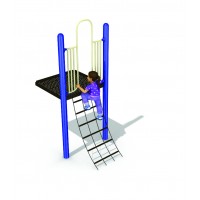Climbers

Public Playground Safety Handbook
CPSC Publication 325
U.S. Consumer Product Safety Commission
5.3.2.1.3 Climbing Rungs
Some of the access methods discussed in §5.2 are also considered climbing devices; therefore, the recommendations for the size of climbing rungs are similar.
• Rungs should be generally round.
• All rungs should be secured in a manner that prevents them from turning.
• Climbing rungs should follow the same diameter recommendations as in §5.2.2. 5.3.2.1.4
Use Zone
• The use zone should extend a minimum of 6 feet in all directions from the perimeter of the stand alone climber. See Figure 8.
• The use zone of a climber may overlap with neighboring equipment if the other piece of equipment allows overlapping use zones and
– There is at least 6 feet between equipment when adjacent designated play surfaces are no more than30 inches high; or – There is at least 9 feet between equipment when adjacent designated play surfaces are more than30 inches high.
5.3.2.1.5 Other considerations
• Climbers should not have climbing bars or other rigid structural components in the interior of the climber onto which a child may fall from a height of greater than 18inches. See Figure 9 for an example of a climber that DOES NOT follow this consideration.
5.3.2.2 Arch Climbers Arch climbers consist of rungs attached to convex side supports. They may be free standing (Figure 10) or be provided as a more challenging means of access to other equipment(Figure 11).
• Arch climbers should not be used as the sole means of access to other equipment for preschoolers.
• Free standing arch climbers are not recommended for toddlers or preschool-age children.
• The rung diameter and spacing of rungs on arch climbers should follow the recommendations for rung ladders in Table 6.
5.3.2.3 Flexible Climbers Flexible climbers use a grid of ropes, chains, cables, or tires for climbing. Since the flexible parts do not provide a steady means of support, flexible climbers require more advanced balance abilities than rigid climbers. Rope, chain, and cable generally form a net-like structure that may be either two or three dimensional. See Figure 12.Tire climbers may have the tires secured tread-to-tread to form a sloping grid, or the tires may be suspended individually by chains or other means.
• Flexible climbers that provide access to platforms should be securely anchored at both ends. • When connected to the ground, the anchoring devices should be installed below ground level and beneath the base of the protective surfacing material.
• Connections between ropes, cables, chains, or between tires should be securely fixed.
• Flexible climbers are not recommended as the sole means of access to equipment intended for toddlers and preschool-age children. • Free-standing flexible climbers are not recommended on playgrounds intended for toddlers and preschool children.
• Spacing between the horizontal and vertical components of a climbing grid should not form entrapment hazards.
• The perimeter of any opening in a net structure should be less than 17 inches or greater than 28 inches (see Figure13).
